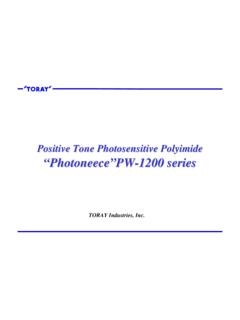Transcription of “Photoneece” CS-series - toray.jp
1 11 PositivePositive--Tone Photosensitive Polyimide CoatingsTone Photosensitive Polyimide Coatingsfor Lens Layer in image sensorsfor Lens Layer in image sensors PhotoneecePhotoneece CSCS--seriesseriesToray Industries, of the characteristic of CS-series22 Thickness m mResolution Aspect ratio=3 Application Inner lens On-chip lens Aqueous developable positive tone PSPI (Photo Sensitive Polyimide) with high , good chemical resistance and high resolution. High Refractive Index Excellent Chemical Stability High resolution Tough product quality Aqueous developable with TMAHCS-7500 basic properties<Current specs >33CS- series have the suitable characteristics for lens layer in Image Sensors012345 PatternabilityTransparencyRefractive IndexShapeThermal stabilityAdhesion strengthLiquid stabilityAcrylicInorganicCS-seriesCS-750 0 vs.
2 Other Materials44 Measurement methodMeasurement method Prism couplerPrism couplerCure ConditionsCure Conditions C C minmin AirAir hotplate)hotplate) Dependency on wavelength>CS-7500 basic length Reflective IndexRefractive Index55020406080100120200 300 400 500 600 700 800wavelength T <Dependency of transparency on wavelength (@thickness 1 m)>CS-7500 basic propertiesMeasurement apparatusMeasurement apparatus Shimadzu UVShimadzu UV--180180 Curing conditionsCuring conditions 300300 C C min(hotplatemin(hotplate)*)**Air curing In case of N2 cure, Transparency=90%/1um@400nm)Transparency (%)6601020304050607080901003004005006007 00800wavelength (nm)T (%)as depo250 C 1min (HP, in air)300 C 1min (HP, in air)Transparency maintains after heat of thermal treatment on its transparencyTransparency (%)77 Curing conditionsCuring conditions(Hot plate)(Hot plate)
3 C C minmin C C minmin C C minmin C C 632nm)632nm)Transparency Transparency %/1um)%/1um) <Curing conditions vs Refractive Index> CS-7500 basic properties88 Pattern profile (after curing)Allay pattern ( m / m)L / S pattern ( / m)HMDS treatment 60 C 20secSpin 700rpm 10 sec and 1700rpm 120secPre bake 120 C 3min @hot plate (thickness )Exposure1650msec (i-line stepper, Focus=0um) : for patterningDevelopment 70 sec. Puddle development @ TMAH sol. (thickness )Cure280 C 5min @hot plate (thickness )99 Pattern profile (thiner film, after curing)HMDS treatment 60 C 20secSpin 700rpm 10 sec and 1500rpm 120secPre bake 120 C 3min @hot plate (thickness )Exposure1160msec (i-line stepper, Focus=0um) : for patterningDevelopment 30 sec.
4 Puddle development @ TMAH sol. (thickness ) J/cm2 broad band @ i-line) : for bleachingCure300 C 5min @hot plate (thickness )2um line / 2um space (thickness )1010 Patterning Process of CS-7500<Film thickness after m recipe example>HMDS 60 C 20secSpin 1500rpm for 120secPrebake120 C 3min (Hot plate) (Thickness m Exposure1400 msec (i-line stepper, Focus=0 m) For patterningDevelopment 50 sec. Puddle development (Thickness m TMAH solution J/cm2 broad band @ i-line) For bleachingCure*280 C 5min (Hot plate ) (Thickness m **Curing Temp.)
5 Range from 2 Curing Temp. range from 22200 C Cto 300to 300 C C1111 Patterning Process of CS-7500< Sensitivity curve >0102030405060708090100110100 1000 Exposure time (msec)Normalized thickness(%)HMDS treatment60 C 20secSpin 1500rpm 120secPre bake 120 C 3min @hot plate (thickness )Exposurei-line stepper, Focus=0umDevelopment 50 sec. Puddle development @ TMAH sol. (thickness )1212 Patterning Process of CS -7500<Film thickness after mrecipe example>HMDS 60 C 20secSpin 700rpm for 10 sec and 1500rpm for 30secPrebake 120 C 3min (Hot plate) (Thickness m Exposure1300 msec (i-line stepper, Focus= m) For patterningDevelopment 50 sec.)
6 Puddle development (Thickness m TMAH solution J/cm2 broad band @ i-line) For high transparencyCure*280 C 5min (Hot plate ) (Thickness m Cure ranges from 2 Cure ranges from 22200 C Cto 300to 300 C C1313<Pattern process recipe by Mark-7>Patterning Process of CS-7500 PI Coating (Mark 7)C/SCoater recipe Manual STEPTimeSpeedAccelerationDispenseArmArm (HP) 60 C X 20 s(sec) (rpm) (rpm/sec)1 2 1 50 1000 1 Home HomeCOL 23 C X 60 s2 0 1000 0 Home Home 3 700 2000 0 HomeHomeCOAT4 1500 1000 0 Home Home 5 0 1000 0 Home HomePre-Bake (HP) 120 C X 180 s Dispense CS-7000 at step 1 COL 23 C X 60 s C/S Exposure1 -line stepper GCA 8000 DSW WAFER STEPPER ET 300 msec (150mJ/cm2)Development recipefocus mSTEP Time SpeedAcceleration(sec) (rpm) (rpm/sec) Development (Mark 7))
7 /Bake1 1000 10000 0C/S2 1000 10000 1 7 3 500 10000 1 7 DEV4 100 10000 1 75 30 10000 1 76 10000 57 10000 58 500 10000 3 4 99 2000 10000 3 4 910 3000 10000 0 Development TMAH Rate L/minRinse DI water)Rate L/minBack rinse DI water Rate 150 mL/minCup exhaust 60 PaNozzle Stream nozzleDispense Developer dispense C/SDispense5 CureCure machine Mark-7(TEL)Cure steps Atmosphere N24 Exposure PLA Broadband 5J/cm2(at iline 280 C 5 min 1500 2500 3500 4500 5500 Rotation speed X rpm 120sec Thickness after Prebaking m Spin curve of CS-7500 (example)




